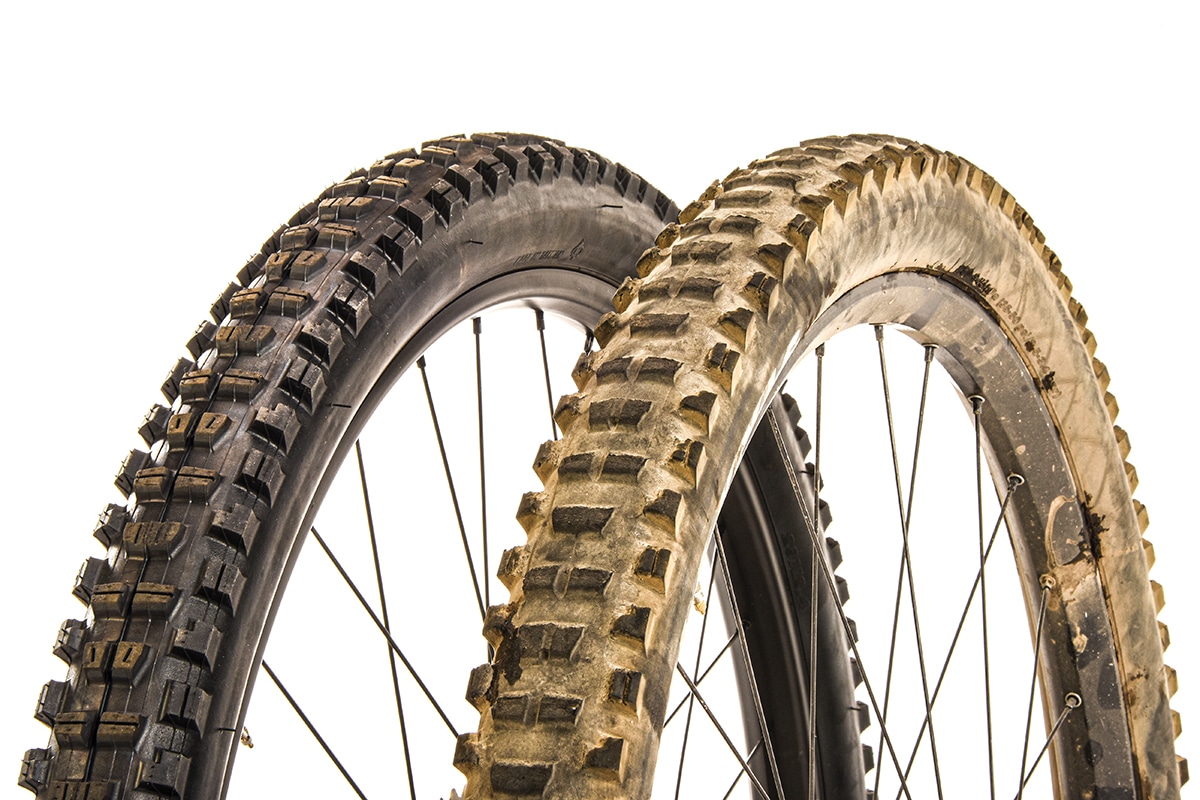Mountain bike tires don’t last forever. Knowing when to replace them is crucial.
Mountain biking is a thrilling activity, but it can be risky with worn-out tires. Tires provide the grip and control you need on rugged trails. Over time, they wear down, affecting performance and safety. Signs like frequent flats, worn treads, or visible tire damage indicate it’s time to change them.
Riding on damaged tires can lead to accidents or injury. Regular checks can save you from unexpected problems. In this guide, we will explore When to Replace Mountain Bike Tires. Stay safe and enjoy the ride with well-maintained tires.

Credit: www.youtube.com
Table of Contents
Signs Of Tire Wear
Knowing when to replace mountain bike tires is crucial. Worn tires can reduce performance and safety. Recognizing the signs of tire wear helps you make informed decisions. Here are the key signs to look for:
Tread Depth
Check your tire’s tread depth regularly. Healthy tires have deep, well-defined treads. If the treads are shallow or smooth, it’s time to replace the tire. Worn treads can cause loss of traction on rough trails. This can lead to dangerous slips and falls.
Cracks And Cuts
Inspect the tire’s surface for cracks and cuts. Small cracks may not seem serious, but they can grow. Cuts, especially deep ones, compromise the tire’s integrity. These damages can lead to sudden blowouts, putting you at risk. Replace tires with visible cracks or cuts immediately.
Performance Decline
Mountain bike tires are essential for a safe and enjoyable ride. Over time, their performance declines. This affects how your bike handles. It also impacts your safety. Knowing when to replace your tires can keep your rides smooth and fun.
Grip Loss
One of the first signs of performance decline is grip loss. Tires wear out with usage. They lose their ability to grip the terrain. If you feel your bike slipping on familiar trails, it’s time to check your tires. Worn-out tread means less control. This can be dangerous, especially on rough paths.
Handling Issues
Worn tires can cause handling issues. They affect your bike’s stability. If you notice your bike wobbling or feeling unsteady, inspect your tires. Uneven wear or bald spots can make steering difficult. This decreases your confidence and increases the risk of accidents.
Mileage Considerations
Understanding when to replace your mountain bike tires is crucial for your safety and performance. One key aspect to consider is the mileage of your tires. Knowing how many miles your tires can handle will help you determine when it’s time for a change. This section will cover the average lifespan of mountain bike tires and the impact of different riding conditions on tire wear.
Average Lifespan
Mountain bike tires typically last between 2,000 and 4,000 miles. The exact mileage depends on various factors. Riding style, tire quality, and maintenance all play a role. High-quality tires generally last longer. Regular inspections help extend their lifespan.
Riding Conditions
Riding conditions greatly affect tire wear. Off-road trails with sharp rocks and roots can wear out tires faster. Smooth trails and paved roads are less harsh on tires. Wet and muddy conditions can also accelerate tire wear. Regularly cleaning your tires helps maintain their condition.
Puncture Frequency
Puncture Frequency is a clear indicator that it might be time to replace your mountain bike tires. Consistent punctures can ruin your ride and affect your bike’s performance. It’s important to monitor how often you get flats to determine if new tires are necessary.
Frequent Flats
If you experience frequent flats, it could be a sign that your tires are worn out. Worn tires are more susceptible to sharp objects. Here are some common causes of frequent flats:
- Thinner tread
- Damaged sidewalls
- Embedded debris
Regularly check your tire’s tread depth and condition. A shallow tread or visible sidewall damage increases the risk of punctures.
Damage Assessment
Conducting a damage assessment can help you determine if it’s time for new tires. Look for these signs:
- Cracks in the rubber
- Bulges or deformities
- Exposed inner casing
If you notice any of these issues, it’s best to replace your tires. Riding on damaged tires can lead to more frequent punctures and potential accidents.
| Sign | Action |
|---|---|
| Frequent Flats | Check tread depth, sidewalls |
| Cracks in Rubber | Replace tires |
| Bulges | Replace tires |
Visual Inspection
Inspect mountain bike tires regularly for visible wear. Replace when tread appears worn or cracks develop on the sidewalls.
Regularly inspecting your mountain bike tires can help identify issues early. Knowing when to replace them ensures your safety on the trail. This section covers what to look for during a visual inspection.
Bulges And Blisters
Bulges and blisters are clear signs of tire damage. These can appear on the tire’s tread or sidewall. Bulges indicate that the tire’s internal structure has weakened. Riding on such tires can be dangerous. They can burst unexpectedly.
Sidewall Damage
Check the sidewalls for cuts or cracks. Sidewall damage can lead to tire failure. Even small cuts can worsen over time. Cracks indicate that the rubber is deteriorating. Replace tires with noticeable sidewall damage immediately.

Credit: mbaction.com
Tire Age
Mountain bike tires do not last forever. Over time, they wear out. Tire age is a key factor in determining when to replace them. Riding on old tires can be risky. Regularly checking tire age ensures a safe and smooth ride.
Manufacture Date
Every tire has a manufacture date. This date tells when the tire was made. Check the sidewall of your tire. Look for a four-digit code. The first two digits show the week. The last two digits show the year. For example, 2518 means the tire was made in the 25th week of 2018.
Rubber Degradation
Rubber degrades over time. Even if the tire looks fine, the rubber can harden. Hardened rubber loses grip. It can crack and become brittle. This can lead to unsafe rides. Regularly inspect your tires for signs of rubber degradation. Look for cracks and dryness.
Mountain bike tires should be replaced every 3 to 5 years. Even if they appear fine, rubber degrades. Stay safe by monitoring the age and condition of your tires.
Riding Style Impact
Riding style significantly impacts the lifespan of your mountain bike tires. Different riding styles wear out tires at different rates. Whether you ride aggressively or casually, understanding your style helps determine when to replace your tires.
Aggressive Riding
Aggressive riding involves tackling rough terrains, steep descents, and jumps. This style puts more stress on your tires. You may notice frequent wear and tear. The treads wear down quickly. Punctures become more common. If you ride aggressively, check your tires often. Look for worn treads or sidewall damage. Replace them if you see significant wear. Safety is crucial.
Casual Riding
Casual riding involves smoother trails and less intense terrain. Tires last longer with this style. The treads don’t wear out as fast. You might need to replace them less frequently. Yet, regular checks are still important. Look for any signs of aging or minor damage. Even casual riders should prioritize safety. If your tires show signs of wear, consider replacing them. Better safe than sorry.
Seasonal Changes
Mountain biking offers a thrilling experience, but tire performance can change with the seasons. Knowing when to replace mountain bike tires depends on the conditions you ride in. Let’s explore how different seasons affect your tires.
Winter Riding
Winter riding challenges your tires with snow, ice, and wet trails. Tires with deep treads provide better grip in these conditions. Check for wear and tear regularly. Replace tires if treads are worn down. This helps maintain traction on slippery surfaces.
Cold weather also hardens rubber compounds. This reduces tire flexibility. If your tires feel stiff, it’s time to replace them. Winter conditions can be harsh. Ensure your tires are in top shape to avoid accidents.
Summer Riding
Summer riding brings dry, dusty trails. Tires need good grip to handle loose dirt. Inspect your tires for cracks and cuts. Heat can degrade rubber faster. Replace tires showing signs of damage.
Traction is crucial on dry trails. Tires with shallow treads might not offer enough grip. Consider replacing them with tires designed for dry conditions. This ensures you stay safe and enjoy your ride.
Frequently Asked Questions
How Often Should I Replace Mountain Bike Tires?
Mountain bike tires should be replaced every 2,000 to 3,000 miles. Check for wear, such as bald spots or frequent flats.
What Are Signs Of Worn-out Mountain Bike Tires?
Look for bald spots, frequent flats, and visible cracks. Reduced grip and traction are also signs to replace your tires.
Can I Replace Just One Mountain Bike Tire?
Yes, you can replace just one tire. However, it’s best to replace both for balanced performance and safety.
Do Mountain Bike Tires Expire?
Mountain bike tires do not have an expiration date but should be replaced every few years regardless of mileage.
Conclusion
Regularly inspect your mountain bike tires. Look for signs of wear. Bald spots, cracks, and frequent flats indicate it’s time. New tires improve safety and performance. Always choose the right type for your trail. Replacing tires may seem costly, but it’s a worthy investment.
Your ride will feel smoother. You’ll ride with confidence. Stay safe and enjoy every adventure. Happy biking!

